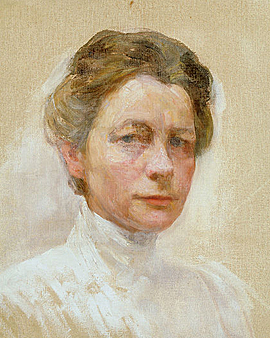


The middle of the 19th century is characterized in literature and art by realism. This trend turned against dramatic, exaggerated and idealising depictions in classicism and romanticism and strove for closeness to everyday life and objectivity. The works of the Slovenian artist Ivana Kobilca are also at home in this epoch. Thus Kobilca's works mainly depict real and typical images of the experiences of her many European journeys and show primarily persons, still lifes and, at a later date, prominent personalities. Her later works are influenced by the impressionism of the late 19th century and thus deal more with the effect of the outside world on the inside of the human being.
Kobilca's art is mainly urban in character, the motifs and colours of her works reflect her social background, her ideals and her travel and life path. Kobilca lived and worked in many European cities, including Vienna, Paris, Florence and Sarajevo. There she also met Maximilian Liebenwein. Her journey through Europe began in 1880, when Kobilca travelled to Munich for vocational training. However, she broke off her training and instead attended Alois Erdtelt's private painting school for women as a pupil of his and met artists such as Rosa Pfäffinger and Käthe Kollwitz. There she learnt portrait painting, which she dedicated herself to again and again in the current years. Kobilca's paintings often show people in the city and in the country.
During her time in Ljubljana, she briefly became a drawing teacher for girls and then travelled to Berlin. During this time Kobilca devoted herself mainly to flower still lifes. Kobilca's works tend to be dark at the beginning, later they become increasingly lighter and finally reflect the typical light blue of those years Kobilca's time in the French capital.
Today Ivana Kobilca is considered the most important Slovenian artist. It is therefore not surprising that her portrait was featured on the 5000 tolar banknote.

The middle of the 19th century is characterized in literature and art by realism. This trend turned against dramatic, exaggerated and idealising depictions in classicism and romanticism and strove for closeness to everyday life and objectivity. The works of the Slovenian artist Ivana Kobilca are also at home in this epoch. Thus Kobilca's works mainly depict real and typical images of the experiences of her many European journeys and show primarily persons, still lifes and, at a later date, prominent personalities. Her later works are influenced by the impressionism of the late 19th century and thus deal more with the effect of the outside world on the inside of the human being.
Kobilca's art is mainly urban in character, the motifs and colours of her works reflect her social background, her ideals and her travel and life path. Kobilca lived and worked in many European cities, including Vienna, Paris, Florence and Sarajevo. There she also met Maximilian Liebenwein. Her journey through Europe began in 1880, when Kobilca travelled to Munich for vocational training. However, she broke off her training and instead attended Alois Erdtelt's private painting school for women as a pupil of his and met artists such as Rosa Pfäffinger and Käthe Kollwitz. There she learnt portrait painting, which she dedicated herself to again and again in the current years. Kobilca's paintings often show people in the city and in the country.
During her time in Ljubljana, she briefly became a drawing teacher for girls and then travelled to Berlin. During this time Kobilca devoted herself mainly to flower still lifes. Kobilca's works tend to be dark at the beginning, later they become increasingly lighter and finally reflect the typical light blue of those years Kobilca's time in the French capital.
Today Ivana Kobilca is considered the most important Slovenian artist. It is therefore not surprising that her portrait was featured on the 5000 tolar banknote.
Page 1 / 1






